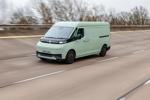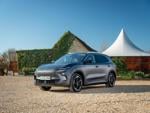Review
Or, in 10 years’ time, will somebody reminisce about the time the French went on a flight of fancy and built a car with sliding doors?
Because for all the attributes or otherwise of the 1007, in the end it comes down to the perception of doors.
The 1007 sits at the lower end of the Peugeot range, above the upcoming 107 but below the 206, and is intended as a useful urban runabout with a little more space than a city car.
It’s got seats which fold and slide, lots of headroom and some very cheap-to-run but under-powered engines.
But what about the doors? For the first time in a car, a major manufacturer has forgone the age-old, tried and tested method of hinging a door and swinging it outwards, and opted for long sliding electrically-powered ones instead.

The advantages for this are immediately apparent. For a start, cars – even little ones like this – are getting bigger while parking spaces stay resolutely the same (after all, wider spaces mean fewer cars and therefore less income) and exiting and entering cars becomes increasingly like sideways limbo dancing.
The solution? Slide the door backwards instead. It has other benefits, too: it is safer for passers-by, especially cyclists often swatted by the sudden spring of an open door.
Peugeot also claims better visibility out of the side windows, while the doors can be operated remotely on the key fob if you’ve got armfuls of shopping or children. It works efficiently and simply. The doors can also be triggered by switches inside the car or by grabbing the handles.
So far, so good. Perhaps the design of small, city cars has taken a bold new step into an easier-to-navigate concrete world.
There are some quibbles, though. Some at the launch of the car questioned the safety of the doors. They can be opened at speed by pulling the handle and obviously don’t have the force of the onrushing air to force them shut. Also, the anti-pinch system (which stops the doors if it senses an obstruction) is good at detecting large objects but is less reactive to smaller, softer ones, which means you’ve got to keep an eye on kids and their meddling mitts.
Ultimately though, doors, whichever method of opening is employed, are potentially dangerous if used stupidly. Stick your head in the way of a normal door and there’s no hope of anti-pinch to rescue you. Opening a door at speed is asking for trouble anyway.
More pertinent is the question of warranty. We are not here to cast aspersions on the reliability of the electric motors which power the doors. Apparently, they are good for 100,000 openings but for a used buyer contemplating a four-year-old car, there is a gamble here which you do not get with any other small car.
If a motor goes wrong after three years/60,000 miles, you can still use the door manually or pay for a new one, and it seems an unnecessary financial risk the traditionally conservative used buyer might avoid, which could have an adverse effect on its appeal second-hand.
However, a major plus point is that the 1007 is a cracking-looking little car. It is cute and boxy while the extended glass gives it real style. In a bold primary colour it has a vivacity about it which will really attract its target market – women living in cities above the age of 25.
Peugeot expects this group to buy about 60% of the 17,000 cars it anticipates selling in a full year. It doesn’t think the 1007 will be a big fleet car, with perhaps only 10% being registered to companies, but it should certainly have some attraction to urban firms needing funky runabouts for small deliveries and, of course, Motability with its wide access doors.
In fact, the 1007 is longer than a 206 and taller than a 307, but it doesn’t look it, and thanks to its doors, has an inherent narrowness no other car has.

At launch, the 1007 will come with a choice of three engines: 75bhp 1.4-litre and 110bhp 1.6-litre petrol, and 70bhp 1.4-litre diesel, and the two petrol engines come with a choice of manual or 2-Tronic automatic gearbox.
These engines are very strong on emissions and fuel economy, with the little diesel doing 64.2mpg on the combined cycle, which makes for some very cheap miles.
Behind the wheel
UNFORTUNATELY, all the engine and gearbox combinations result in cars which are on the slow side, while the diesel engine is on the far side of painfully slow. Part of the reason is that the 1007 is a heavy car for its size, weighing in at around 1,100-1,200kg, and these are not powerful engines.
They are all right for stop-start city work, but find an open road and acceleration above 30mph is a laborious process. The best is the bigger petrol engine, and the 2-tronic box is slicker, smoother and sharper than its Citroen Sensodrive cousin, but it is still not silky.
Peugeot executives promise more powerful engines in the future and to be honest, the sooner the better.
The driving experience is also adequate, at best, for a car of this type. There is plenty of room up front and the seating position is comfortable (although the steering wheel was offset heavily on the left-hand drive models at launch). The ultra-light electric steering is fine around the city, although it doesn’t really weight up much as speed increases. Driving on open roads in the 1007 is about getting from A to B – don’t expect much fun.
Because of the distance of the B-pillar, the seat belt is miles away and, for smaller drivers, comes from such an angle that it cuts into the neck and it is a stretch backwards to reach it. Immobile, older drivers, for whom this car’s easy access would be ideal, would find this a real struggle.

It’s much of the same with the rest of the car. There’s plenty of space up front, less so in the back and very little in the boot. The rear seats slide forwards and also hinge up to rest against the front seats, but it’s a very flimsy feeling system and you can’t have the front seats very far back when the rears are butting against them.
To lock the front seats in place you have to slide them right back first and then forwards, so you have to guess at the point at which the folded rear seats will sit. It just feels a little underdeveloped.
Driving verdict
ON the whole, Peugeot is on to something here with those rather cunning doors and funky looks but there are issues of engines and the whole driving experience which need to be addressed. Some longer warranties on those electric doors wouldn’t go amiss either.
| Model | 1.4 | 1.6 | 1.4 HDi | |||
| Engine (cc) | 1,360 | 1,587 | 1,398 | |||
| Max power (bhp/rpm) | 75/5,400 | 110/5,750 | 70/4,000 | |||
| Max torque (lb-ft/rpm) | 88/3,300 | 110/4,000 | 120/2,000 | |||
| Max speed (mph) | 102 | 117 | 99 | |||
| 0-62mph (sec) | 14.4 | 11.8 | 15.4 | |||
| Comb fuel consumption (mpg) | 45.6 | 42.8 | 64.2 | |||
| CO2 emissions (g/km) | 153 | 156 | 115 | |||
Prices (OTR): £10,850 – £12,600














